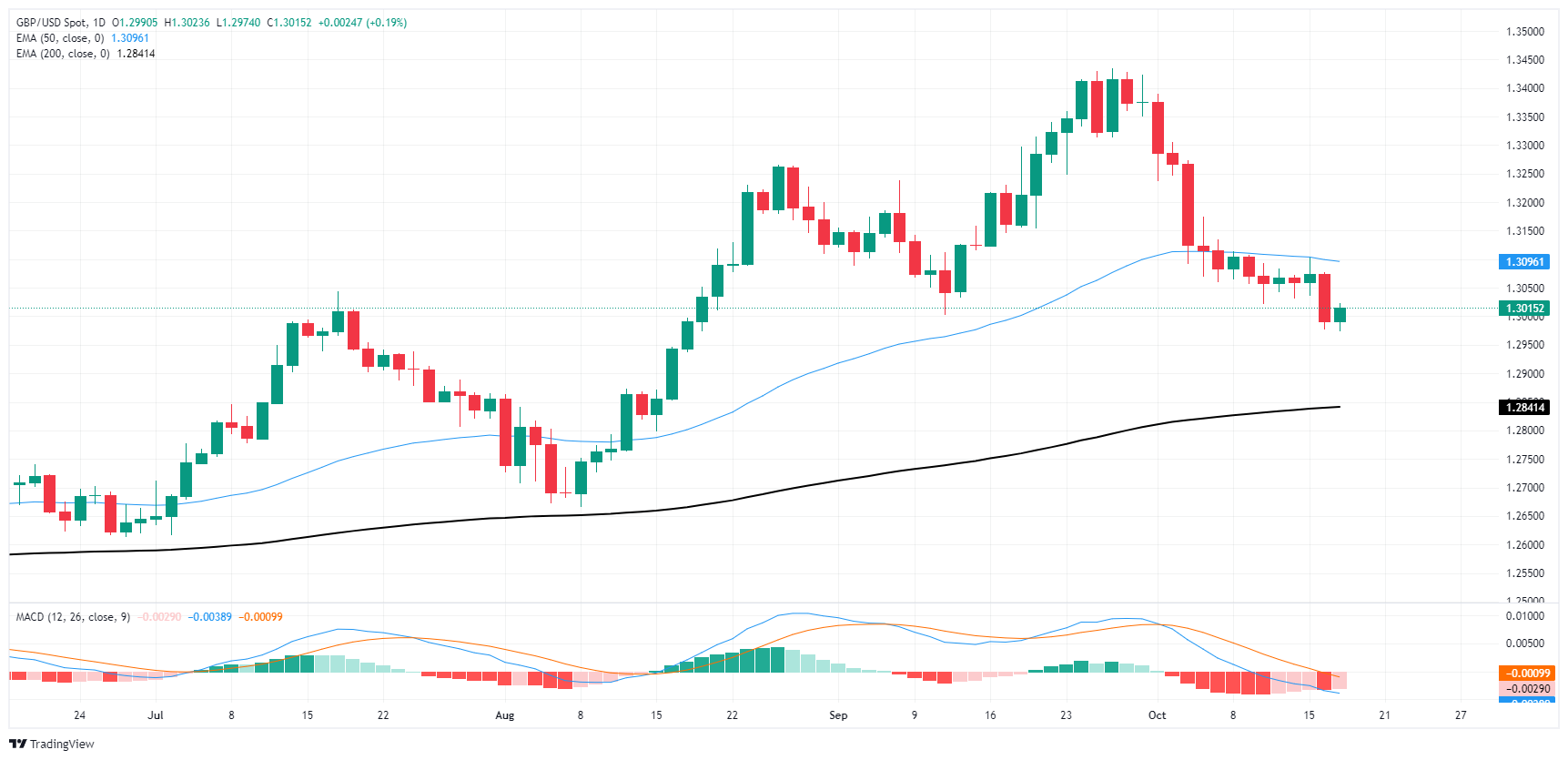GBP/USD halts the slide for now
- GBP/USD pumped the brakes on recent declines, but upside remains elusive.
- UK economic data has given Pound bulls little to be bullish about.
- US data, on the other hand, continues to outpace expectations.
GBP/USD managed to plug the leaks and stop its most recent backslide, but potential for a bullish rebound remains tepid at best. The Pound Sterling clawed back a scant sixth of a percent against the Greenback on Thursday, well short of the midweek plunge that saw Cable slump another six-tenths of a percent.
GBP/USD remains off of recent highs by over 3% after a one-sided backslide from its last peak near 1.3450. The pair is once again battling it out near the 1.3000 handle as GBP bidders struggle to find a reason to buy Cable.
UK data has broadly missed the mark this week, with UK Consumer Price Index (CPI) inflation, Producer Price Index (PPI) inflation, and UK labor figures all undershot market forecasts. With UK inflation flopping steeper than many expected, and jobs data failing to hit investor expectations, the Bank of England (BoE) will face increasing pressure from markets to step up the pace of rate cuts.
All that’s left of note on the GBP side of this week’s economic data docket will be Friday’s UK Retail Sales figures. Even here, markets aren’t expecting much in the way of magic, with median market forecasts expecting a -0.3% contraction in September compared to August’s comparatively strong showing of 1.0%.
US data, on the other hands, broadly rewarded Greenback bidders. US Retail Sales grew by 0.4% MoM in September, recovering from August’s 0.1% and beating median market forecasts of a 0.3% print. Retail Sales excluding Automotive spending also thumped forecasts, growing by 0.5% in September compared to the expected 0.1%, and easily vaulting over August’s 0.2% increase.
US Initial Jobless Claims for the week ended October 11 also beat market expectations, coming in at 241K for the week. Investors expected the week’s new jobless claimant count to hold steady at the previous week’s revised 260K.
GBP/USD price forecast
GBP/USD remains under selling pressure as the pair consolidates just above the 1.3000 psychological level, having recently broken below the 50-day Exponential Moving Average (EMA) at 1.3096. This bearish break signals a potential continuation of the downward trend, with the 200-day EMA at 1.2841 serving as a critical support level in the near term. Despite the current mild rebound, bearish sentiment remains dominant, and any recovery could face resistance near the 50-day EMA, now acting as a dynamic resistance point. A failure to reclaim 1.3050 could attract further selling interest.
The Moving Average Convergence Divergence (MACD) indicator is flashing warning signs of deeper downside risk, as both the MACD line and the signal line remain in negative territory. The histogram is showing signs of weakening bearish momentum, but the overall bias remains to the downside. A sustained break below 1.3000 could open the door toward the 1.2900 handle, with a further drop potentially targeting the 200-day EMA. Conversely, any recovery above the 1.3050 level would be needed to invalidate the bearish outlook, with a potential upside target of 1.3150.
GBP/USD daily chart
Pound Sterling FAQs
The Pound Sterling (GBP) is the oldest currency in the world (886 AD) and the official currency of the United Kingdom. It is the fourth most traded unit for foreign exchange (FX) in the world, accounting for 12% of all transactions, averaging $630 billion a day, according to 2022 data. Its key trading pairs are GBP/USD, also known as ‘Cable’, which accounts for 11% of FX, GBP/JPY, or the ‘Dragon’ as it is known by traders (3%), and EUR/GBP (2%). The Pound Sterling is issued by the Bank of England (BoE).
The single most important factor influencing the value of the Pound Sterling is monetary policy decided by the Bank of England. The BoE bases its decisions on whether it has achieved its primary goal of “price stability” – a steady inflation rate of around 2%. Its primary tool for achieving this is the adjustment of interest rates. When inflation is too high, the BoE will try to rein it in by raising interest rates, making it more expensive for people and businesses to access credit. This is generally positive for GBP, as higher interest rates make the UK a more attractive place for global investors to park their money. When inflation falls too low it is a sign economic growth is slowing. In this scenario, the BoE will consider lowering interest rates to cheapen credit so businesses will borrow more to invest in growth-generating projects.
Data releases gauge the health of the economy and can impact the value of the Pound Sterling. Indicators such as GDP, Manufacturing and Services PMIs, and employment can all influence the direction of the GBP. A strong economy is good for Sterling. Not only does it attract more foreign investment but it may encourage the BoE to put up interest rates, which will directly strengthen GBP. Otherwise, if economic data is weak, the Pound Sterling is likely to fall.
Another significant data release for the Pound Sterling is the Trade Balance. This indicator measures the difference between what a country earns from its exports and what it spends on imports over a given period. If a country produces highly sought-after exports, its currency will benefit purely from the extra demand created from foreign buyers seeking to purchase these goods. Therefore, a positive net Trade Balance strengthens a currency and vice versa for a negative balance.
